 A French drain is a simple drainage solution that is often mistaken for something far more complex. One factor affecting this perception could be the French drain’s many aliases. A French drain is also called a weeping tile, a blind drain, a rock drain, a rubble drain, a drain tile, a perimeter drain, a French ditch, a land drain, a sub-surface drain, a sub-soil drain, or an agricultural drain. With so many different names, it can be easy to get confused about what it is that is actually being installed in your basement. Continue reading →
A French drain is a simple drainage solution that is often mistaken for something far more complex. One factor affecting this perception could be the French drain’s many aliases. A French drain is also called a weeping tile, a blind drain, a rock drain, a rubble drain, a drain tile, a perimeter drain, a French ditch, a land drain, a sub-surface drain, a sub-soil drain, or an agricultural drain. With so many different names, it can be easy to get confused about what it is that is actually being installed in your basement. Continue reading →
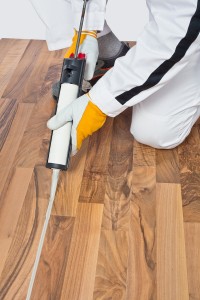 Basement water damage can be a real hassle. The mess, the clean-up, the costly repairs. A consistently damp or wet basement can lead to skyrocketing humidity levels and excessive mold growth. In a sense, water is your basement’s worst enemy. If excess moisture, leaks, standing water, and other water-related issues are not promptly and adequately corrected, you could be looking at long-term damage and extensive (not to mention expensive) repairs. Continue reading →
Basement water damage can be a real hassle. The mess, the clean-up, the costly repairs. A consistently damp or wet basement can lead to skyrocketing humidity levels and excessive mold growth. In a sense, water is your basement’s worst enemy. If excess moisture, leaks, standing water, and other water-related issues are not promptly and adequately corrected, you could be looking at long-term damage and extensive (not to mention expensive) repairs. Continue reading →
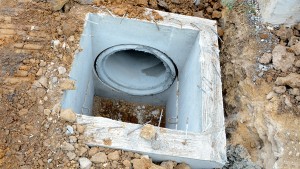 Do you suspect that you may have a drainage problem? If the answer to this question is yes, it’s possible that the thought of attempting to repair the issue on your own may have crossed your mind. After all, plenty of home projects are great DIY opportunities. And doing it yourself can save you a ton of cash. While things such as painting, landscaping, and refinishing cabinetry all make great do-it-yourself projects, repairing drainage problems does not fall into the category of home repair and improvement tasks that can be completed without the use of a qualified professional. Continue reading →
Do you suspect that you may have a drainage problem? If the answer to this question is yes, it’s possible that the thought of attempting to repair the issue on your own may have crossed your mind. After all, plenty of home projects are great DIY opportunities. And doing it yourself can save you a ton of cash. While things such as painting, landscaping, and refinishing cabinetry all make great do-it-yourself projects, repairing drainage problems does not fall into the category of home repair and improvement tasks that can be completed without the use of a qualified professional. Continue reading →
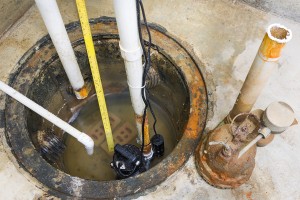 When it comes to a home that is already suffering from considerable water entry into the basement, there’s no question that some serious work will need to be done to remedy the situation. The question then becomes, how serious are you willing to go to address the problem? There are two primary methods that any waterproofing expert will recommend, and the biggest difference between them is the method of execution. The comparatively less expensive, less obtrusive way is through interior water proofing in the basement itself. The more expensive, more comprehensive way, is exterior waterproofing, which is only less intrusive when a house is being constructed. Continue reading →
When it comes to a home that is already suffering from considerable water entry into the basement, there’s no question that some serious work will need to be done to remedy the situation. The question then becomes, how serious are you willing to go to address the problem? There are two primary methods that any waterproofing expert will recommend, and the biggest difference between them is the method of execution. The comparatively less expensive, less obtrusive way is through interior water proofing in the basement itself. The more expensive, more comprehensive way, is exterior waterproofing, which is only less intrusive when a house is being constructed. Continue reading →
 There’s that old saying, “It’s not the heat, it’s the humidity,” that takes the blame for summer discomfort away from the temperature and puts it somewhere else. But what is humidity, and what can it do to a home? Continue reading →
There’s that old saying, “It’s not the heat, it’s the humidity,” that takes the blame for summer discomfort away from the temperature and puts it somewhere else. But what is humidity, and what can it do to a home? Continue reading →
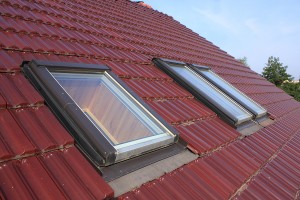 Despite the fact that the phrase “roof over our heads” is synonymous with safe shelter, very few people give much thought to how important the roof is to the overall welfare of the home and its residents. To many, the roof is just something that keeps the rain out, and some make many modifications to the roof in order to make it more “useful,” installing skylights, adding solar panels, or even just old fashioned features like chimneys. Various vents for other appliances as well as other features all act as points of penetration on a roof where rain water or melt water from a spring snow melt can get into a home. Continue reading →
Despite the fact that the phrase “roof over our heads” is synonymous with safe shelter, very few people give much thought to how important the roof is to the overall welfare of the home and its residents. To many, the roof is just something that keeps the rain out, and some make many modifications to the roof in order to make it more “useful,” installing skylights, adding solar panels, or even just old fashioned features like chimneys. Various vents for other appliances as well as other features all act as points of penetration on a roof where rain water or melt water from a spring snow melt can get into a home. Continue reading →
 One of the worst scenarios for a water damage is a flooded basement, but one of the worst ways that a basement can flood is through sewer lines. This happens when heavy rains or any other form of excessive water overwhelms a sewage system, and rather than flowing safely away from homes, the sewer, over its own capacity, starts forcing water out any way it can, including back out into homes. Continue reading →
One of the worst scenarios for a water damage is a flooded basement, but one of the worst ways that a basement can flood is through sewer lines. This happens when heavy rains or any other form of excessive water overwhelms a sewage system, and rather than flowing safely away from homes, the sewer, over its own capacity, starts forcing water out any way it can, including back out into homes. Continue reading →
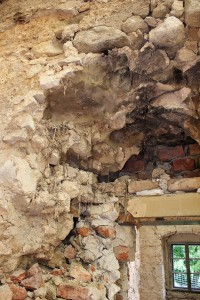 Dry rot is a condition that can affect any sort of dead wood, including the wood used to build houses. It affects the wood’s strength and durability, and if it advances far enough the wood can disintegrate completely at the slightest touch. However, despite the name, dry rot is caused by an excess of moisture. Continue reading →
Dry rot is a condition that can affect any sort of dead wood, including the wood used to build houses. It affects the wood’s strength and durability, and if it advances far enough the wood can disintegrate completely at the slightest touch. However, despite the name, dry rot is caused by an excess of moisture. Continue reading →
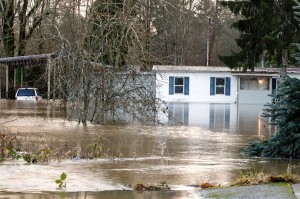 While there are a number of precautions home and building owners can take to minimize the possibility of basement floods, sometimes extraordinary circumstances may still cause just such an event to occur. An actual flood situation, an excessive snow melt, extremely heavy rains, or even a burst water pipe can overwhelm certain mechanisms designed to fend off smaller causes of flooding, leaving you with a flooded basement. If such a thing happens to you, you should be aware that you are in a potentially dangerous situation, and you should act accordingly to maximize the safety of anyone in the home or building. Here are a few of the things you should keep in mind if you encounter a flooded basement. Continue reading →
While there are a number of precautions home and building owners can take to minimize the possibility of basement floods, sometimes extraordinary circumstances may still cause just such an event to occur. An actual flood situation, an excessive snow melt, extremely heavy rains, or even a burst water pipe can overwhelm certain mechanisms designed to fend off smaller causes of flooding, leaving you with a flooded basement. If such a thing happens to you, you should be aware that you are in a potentially dangerous situation, and you should act accordingly to maximize the safety of anyone in the home or building. Here are a few of the things you should keep in mind if you encounter a flooded basement. Continue reading →
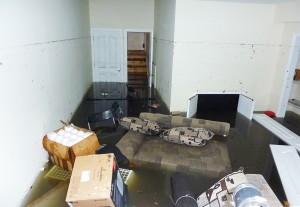 With leaky or flooded basements, the problem is easy to spot; liquid water is getting into your basement, usually through a crack in the walls and/or foundation of the building. But when a basement is damp, and there doesn’t appear to be any likely place for water to get in, how and why does this happen? And more importantly, is there anything you can do about it? Continue reading →
With leaky or flooded basements, the problem is easy to spot; liquid water is getting into your basement, usually through a crack in the walls and/or foundation of the building. But when a basement is damp, and there doesn’t appear to be any likely place for water to get in, how and why does this happen? And more importantly, is there anything you can do about it? Continue reading →
 A French drain is a simple drainage solution that is often mistaken for something far more complex. One factor affecting this perception could be the French drain’s many aliases. A French drain is also called a weeping tile, a blind drain, a rock drain, a rubble drain, a drain tile, a perimeter drain, a French ditch, a land drain, a sub-surface drain, a sub-soil drain, or an agricultural drain. With so many different names, it can be easy to get confused about what it is that is actually being installed in your basement. Continue reading →
A French drain is a simple drainage solution that is often mistaken for something far more complex. One factor affecting this perception could be the French drain’s many aliases. A French drain is also called a weeping tile, a blind drain, a rock drain, a rubble drain, a drain tile, a perimeter drain, a French ditch, a land drain, a sub-surface drain, a sub-soil drain, or an agricultural drain. With so many different names, it can be easy to get confused about what it is that is actually being installed in your basement. Continue reading → 
 Basement water damage can be a real hassle. The mess, the clean-up, the costly repairs. A consistently damp or wet basement can lead to skyrocketing humidity levels and excessive mold growth. In a sense, water is your basement’s worst enemy. If excess moisture, leaks, standing water, and other water-related issues are not promptly and adequately corrected, you could be looking at long-term damage and extensive (not to mention expensive) repairs.
Basement water damage can be a real hassle. The mess, the clean-up, the costly repairs. A consistently damp or wet basement can lead to skyrocketing humidity levels and excessive mold growth. In a sense, water is your basement’s worst enemy. If excess moisture, leaks, standing water, and other water-related issues are not promptly and adequately corrected, you could be looking at long-term damage and extensive (not to mention expensive) repairs.  Do you suspect that you may have a drainage problem? If the answer to this question is yes, it’s possible that the thought of attempting to repair the issue on your own may have crossed your mind. After all, plenty of home projects are great DIY opportunities. And doing it yourself can save you a ton of cash. While things such as painting, landscaping, and refinishing cabinetry all make great do-it-yourself projects, repairing drainage problems does not fall into the category of home repair and improvement tasks that can be completed without the use of a qualified professional.
Do you suspect that you may have a drainage problem? If the answer to this question is yes, it’s possible that the thought of attempting to repair the issue on your own may have crossed your mind. After all, plenty of home projects are great DIY opportunities. And doing it yourself can save you a ton of cash. While things such as painting, landscaping, and refinishing cabinetry all make great do-it-yourself projects, repairing drainage problems does not fall into the category of home repair and improvement tasks that can be completed without the use of a qualified professional.  When it comes to a home that is already suffering from considerable water entry into the basement, there’s no question that some serious work will need to be done to remedy the situation. The question then becomes, how serious are you willing to go to address the problem? There are two primary methods that any waterproofing expert will recommend, and the biggest difference between them is the method of execution. The comparatively less expensive, less obtrusive way is through interior water proofing in the basement itself. The more expensive, more comprehensive way, is exterior waterproofing, which is only less intrusive when a house is being constructed.
When it comes to a home that is already suffering from considerable water entry into the basement, there’s no question that some serious work will need to be done to remedy the situation. The question then becomes, how serious are you willing to go to address the problem? There are two primary methods that any waterproofing expert will recommend, and the biggest difference between them is the method of execution. The comparatively less expensive, less obtrusive way is through interior water proofing in the basement itself. The more expensive, more comprehensive way, is exterior waterproofing, which is only less intrusive when a house is being constructed.  There’s that old saying, “It’s not the heat, it’s the humidity,” that takes the blame for summer discomfort away from the temperature and puts it somewhere else. But what is humidity, and what can it do to a home?
There’s that old saying, “It’s not the heat, it’s the humidity,” that takes the blame for summer discomfort away from the temperature and puts it somewhere else. But what is humidity, and what can it do to a home?  Despite the fact that the phrase “roof over our heads” is synonymous with safe shelter, very few people give much thought to how important the roof is to the overall welfare of the home and its residents. To many, the roof is just something that keeps the rain out, and some make many modifications to the roof in order to make it more “useful,” installing skylights, adding solar panels, or even just old fashioned features like chimneys. Various vents for other appliances as well as other features all act as points of penetration on a roof where rain water or melt water from a spring snow melt can get into a home.
Despite the fact that the phrase “roof over our heads” is synonymous with safe shelter, very few people give much thought to how important the roof is to the overall welfare of the home and its residents. To many, the roof is just something that keeps the rain out, and some make many modifications to the roof in order to make it more “useful,” installing skylights, adding solar panels, or even just old fashioned features like chimneys. Various vents for other appliances as well as other features all act as points of penetration on a roof where rain water or melt water from a spring snow melt can get into a home.  One of the worst scenarios for a water damage is a flooded basement, but one of the worst ways that a basement can flood is through sewer lines. This happens when heavy rains or any other form of excessive water overwhelms a sewage system, and rather than flowing safely away from homes, the sewer, over its own capacity, starts forcing water out any way it can, including back out into homes.
One of the worst scenarios for a water damage is a flooded basement, but one of the worst ways that a basement can flood is through sewer lines. This happens when heavy rains or any other form of excessive water overwhelms a sewage system, and rather than flowing safely away from homes, the sewer, over its own capacity, starts forcing water out any way it can, including back out into homes.  Dry rot is a condition that can affect any sort of dead wood, including the wood used to build houses. It affects the wood’s strength and durability, and if it advances far enough the wood can disintegrate completely at the slightest touch. However, despite the name, dry rot is caused by an excess of moisture.
Dry rot is a condition that can affect any sort of dead wood, including the wood used to build houses. It affects the wood’s strength and durability, and if it advances far enough the wood can disintegrate completely at the slightest touch. However, despite the name, dry rot is caused by an excess of moisture.  While there are a number of precautions home and building owners can take to minimize the possibility of basement floods, sometimes extraordinary circumstances may still cause just such an event to occur. An actual flood situation, an excessive snow melt, extremely heavy rains, or even a burst water pipe can overwhelm certain mechanisms designed to fend off smaller causes of flooding, leaving you with a flooded basement. If such a thing happens to you, you should be aware that you are in a potentially dangerous situation, and you should act accordingly to maximize the safety of anyone in the home or building. Here are a few of the things you should keep in mind if you encounter a flooded basement.
While there are a number of precautions home and building owners can take to minimize the possibility of basement floods, sometimes extraordinary circumstances may still cause just such an event to occur. An actual flood situation, an excessive snow melt, extremely heavy rains, or even a burst water pipe can overwhelm certain mechanisms designed to fend off smaller causes of flooding, leaving you with a flooded basement. If such a thing happens to you, you should be aware that you are in a potentially dangerous situation, and you should act accordingly to maximize the safety of anyone in the home or building. Here are a few of the things you should keep in mind if you encounter a flooded basement.  With leaky or flooded basements, the problem is easy to spot; liquid water is getting into your basement, usually through a crack in the walls and/or foundation of the building. But when a basement is damp, and there doesn’t appear to be any likely place for water to get in, how and why does this happen? And more importantly, is there anything you can do about it?
With leaky or flooded basements, the problem is easy to spot; liquid water is getting into your basement, usually through a crack in the walls and/or foundation of the building. But when a basement is damp, and there doesn’t appear to be any likely place for water to get in, how and why does this happen? And more importantly, is there anything you can do about it?